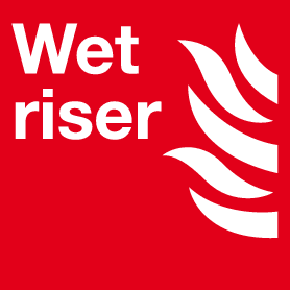Wet riser
Wet risers are used to supply water within buildings for firefighting purposes. The provision of a built-in water distribution system means that firefighters do not need to create their own distribution system in order to fight a fire and avoids the breaching of fire compartments by running hose lines between them.
Wet risers are permanently charged with water. This is as opposed to dry risers which do not contain water when they are not being used, but are charged with water by fire service pumping appliances when necessary.
Part B of the building regulations (Fire Safety) requires that fire mains are provided in all buildings that are more than 18 m tall. In buildings less than 50 m tall, either a wet riser or dry riser fire main can be provided. However, where a building extends to more than 50 m above the rescue service vehicle access level, wet risers are necessary as the pumping pressure required to charge the riser is higher than can be provided by a fire service appliance, and to ensure an immediate supply of water is available at high level.
Wet risers are charged with water from a pressurised supply, often pumped from a storage tank, with landing valves at specified locations on each floor.
It should be possible for fire service pumping appliances to supplement the supply to wet risers in the event of an emergency, such as storage tanks running low during long events. Pumping appliances should be able to access ‘…within 18 m and within sight of, a suitable entrance giving access to the main and in sight of the inlet.’
Generally, a wet riser supply system should be capable of maintaining a minimum running pressure at top outlet at roof level of 4 bar at a flow rate of 22.7l/s. the maximum running pressure permitted with only one outlet in operation is 5 bar.
Wet risers should be within fire-fighting shafts, and where necessary in protected escape stairs. Wet riser outlets, or 'landing valves' may be within in protected lobbies, stairs or enclosures where these are available.
Wet risers should be inspected and tested regularly to ensure equipment is functioning correctly and ready for use. Problems can be very serious in the event of a fire, and are typically caused by vandalism or theft, blockages or pipework failure or by connection failure or outlets being open.
NB Planning Gateway One - Glossary, published on the Planning Portal, defines a wet riser as: ‘A water supply pipe installed in a building for fire-fighting purposes and permanently charged with water from a pressurised supply, and fitted with landing valves at specified points.’
[edit] Related articles on Designing Buildings
- Approved documents.
- Building regulations.
- Dry riser.
- Fire and rescue service.
- Fire detection and alarm systems.
- Firefighting route.
- Joint fire code.
- Protected escape route.
- The Regulatory Reform (Fire Safety) Order 2005.
- Unprotected escape route.
- Vertical riser.
[edit] External references.
- Approved document B2.
- High-rise fire fighting. Wet risers.
Quick links
[edit] Legislation and standards
Fire Safety (England) Regulations 2022
Regulatory Reform (Fire Safety) Order 2005
Secondary legislation linked to the Building Safety Act
Building safety in Northern Ireland
[edit] Dutyholders and competencies
BSI Built Environment Competence Standards
Competence standards (PAS 8671, 8672, 8673)
Industry Competence Steering Group
[edit] Regulators
National Regulator of Construction Products
[edit] Fire safety
Independent Grenfell Tower Inquiry
[edit] Other pages
Building Safety Wiki is brought to you courtesy of:





